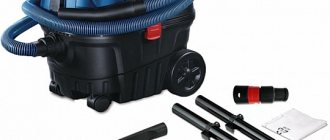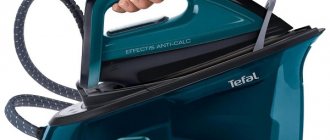Previously, the refrigerator was a loud unit, where avalanches of ice had to be literally scraped off with a knife. Modern models are silent, differ in the range of functions and sizes. There are several basic automatic defrosting systems. And when choosing the appropriate equipment model, the question arises about which refrigerator is better: know frost or drip.
Long gone are the days of loud refrigerators, the ice from which had to be chipped off in layers 50 mm thick with a knife.
Difference between drip and No Frost refrigerator
First, it’s worth understanding how know frost refrigerators differ from drip refrigerators. The main difference is hidden in the operation of the equipment. Therefore, it is worth understanding the features of each system.
Now, for comfort, several automatic defrosting systems are offered (drip and No Frost), each of which has its own advantages and disadvantages.
Drip units can have from 1 to 3 refrigeration chambers and come in different sizes, from compact to large. They consume little energy, most models have an attractive design. There is an automatic defrosting function, but you need to disconnect the equipment from the power supply and wash it at least once a year. This will prevent the appearance of an unpleasant odor.
To figure out which refrigerator is better, you need to consider in detail their structure and operating principles.
The basis of the system is the ability to remove moisture from the chamber using the coldest wall. It is in this area that all the liquid collects, then flows into a designated container and is removed.
Despite automatic defrosting, such refrigerators still need to be disconnected from the power supply at least once a year and the internal surfaces washed to prevent unpleasant odors.
Note! The described process is repeated several times a day. Therefore, if you find a wet panel in the refrigerator, you should not take any action. The equipment will independently cope with excess moisture.
The No Frost system is considered relatively new. It differs from the drip model in that the user does not see the defrosting stages. Cold air is distributed throughout such a unit using a system of ducts and fans. This allows the temperature to be evenly distributed over the entire area. No Frost has a special built-in timer. When it starts, the heating element begins to work, due to which the accumulated ice begins to melt. The resulting liquid flows into the container, and its evaporation occurs outside. As a result, moisture is regularly removed from the unit, and its internal walls remain dry.
Refrigerators with the No Frost system appeared relatively recently and have become powerful competitors to all other types.
The difference between the systems lies in the operation of each of them. No Frost, thanks to a special air circulation process inside the equipment, does not form ice on the walls or icicles. Defrosting and removing moisture occurs in hidden mode. The drip system is designed differently. The rear wall of the equipment is the evaporator. It is there that condensation forms, which subsequently flows into a container intended for this purpose. The user may notice the formation of liquid and its flow down the wall.
Refrigerators with the No Frost defrosting system have a slightly different set of key components. They are complemented by a fan with a motor and a heating element.
When using both systems, the user does not need to take part in the defrosting process of the unit.
Note! In drip models, the drain hole may become clogged. This will cause a puddle to form in one area of the refrigerator.
The drip defrosting system of a refrigerator is the removal of moisture from the chamber by collecting it on the coldest wall, along which it flows into a special container and is removed outside.
Tips for choosing
Having compared the two automatic defrosting systems, we see that they both have their advantages and some disadvantages. Therefore, each buyer chooses a refrigerator for himself, taking into account his needs and other parameters: cost, size, minimum temperature in the freezer.
For many, a good option would be a device with a drip system installed in the refrigerator compartment and a No Frost system in the freezer. It will be cheaper than Full No Frost, but this will not affect functionality.
Source
Advantages and disadvantages
Each system has a set of advantages and disadvantages. They, among other things, contain the main nuances of the differences between the units. You should familiarize yourself with the pros and cons of each equipment. This will allow you to better make your choice and take into account the problems and difficulties that you may encounter during operation.
The fundamental differences lie in the operating scheme of the unit itself.
Drip system
Among the advantages of this type of equipment it is worth noting:
- The volume of the internal chamber is larger than that of units with the No Frost system. This was achieved thanks to the absence of built-in fans, which do not take up extra space;
- Wide range of models. You can choose equipment for rooms of any size and interior;
- Due to the wide selection of models, their prices vary. Therefore, you will be able to choose an option to suit any budget and purse;
- Modern models are distinguished by silent operation;
- Energy is used economically due to the fact that the design contains fewer energy-consuming parts than models with No Frost.
The disadvantages of the drip type include:
- At least once a year you need to defrost it yourself, and also wash all internal areas;
- In the absence of proper maintenance and care, the drain hole becomes clogged, which will lead to the appearance of puddles inside the unit;
- When the door is opened, the refrigerator of such a system will gain temperature more slowly than its opponent with a different system;
- The user needs to configure the operation of the equipment. And if you do it wrong, the condensation on the back wall will begin to freeze. The owner will have to manually defrost;
- There is no uniform temperature distribution over the entire internal area. It is warmer at the top than at the bottom. It is important to take this fact into account when choosing places to place different categories of products.
If you notice a “crying” panel in the refrigerator, you should not do anything - this is a normal operation process.
No Frost systems
Among the advantages of the system are:
- The temperature is evenly distributed throughout the entire work area. The only exceptions are individual chambers belonging to the designated freshness zone;
- Manual defrosting is rarely done. The unit does not require such a procedure to be carried out regularly. It is performed as a preventive measure;
- Caring for equipment comes down to regular wiping of the shelves. The unit does not require additional manipulations;
- High speed of food freezing;
- After opening or closing the door, the refrigerator is able to reach the desired temperature in just a few seconds;
- This system is ideal for freezers.
If in the drip type of defrosting users can see what stage the device is currently in, then in No Frost these processes are hidden from the user.
No Frost also has some disadvantages. Among them:
- High cost of models. Especially compared to chamber ones;
- Due to the presence of fans, there is less space in the chamber compared to models equipped with a chamber system;
- The unit contains many energy-consuming elements. This affects the energy consumed, which is consumed in large quantities.
The water flows through the drainage system into a special container installed on the compressor and evaporates from the outside. This keeps the walls of the refrigerator chambers constantly dry and regularly removes moisture from it.
Sometimes on equipment with the No Frost system you can find a little condensation on the back wall. Compared to the drip model, the amount of such moisture is minimal. This usually indicates that the door of the unit was kept open for a long time or that products with high humidity were placed inside.
The most advanced option is No Frost in both chambers, with separate temperature control in each.
Common Misconceptions
According to some people, in refrigerators with the “No Frost” system, food is dried out. To some extent, this is true, because fans are installed in the refrigerator compartment. However, compared to drip analogues, the drying speed of products is not so high. In addition, modern refrigerators are often equipped with plastic containers, which not only extend the shelf life of food, but also prevent odors from mixing with each other.
Sometimes people are mistaken that refrigerators with the “No Frost” system do not need to be defrosted. Despite good ventilation, small pieces of ice still accumulate on the back wall of the chamber. Therefore, once a year it is recommended to turn off the refrigeration unit and clean the interior.
Quite often you can come across a myth about the dangers of the “No Frost” system. This is pure fiction. The main components of refrigerators with this function are the same as those installed on analogues with a drip system.
Differences between drip and No Frost auto defrost technologies
Some differences have already been noted in defrosting a no frost or drip refrigerator. It is with this process that the main differences in these types of equipment are associated. Manufacturers produce various models, and in some, these systems may be combined. So, the refrigerator can have a drip type of defrosting in the main chamber, and the freezing part will work according to the No Frost system. There are also models that operate completely according to the No Frost type with the ability to independently regulate the temperature in each compartment.
Both systems allow refrigerators to operate smoothly and save their owners from regularly removing all products and waiting 10-15 hours to remove a thick layer of ice.
Both options do not require constant manual defrosting. However, the drip version must be defrosted and washed once a year. No Frost can also sometimes be defrosted on its own, but only as a preventive measure. In general, the unit can do without these manipulations.
Automatic thawing of frozen moisture and its removal are provided for by the design of both devices.
From a functional point of view, the systems are not much different. Both types of refrigerator can work well for a long time and defrost efficiently. At the same time, the freezer is not equipped with a drip system due to the fact that a negative temperature must always be maintained inside it. Therefore, it has either the No Frost type or manual, which requires defrosting the chamber at least every six months.
Therefore, from a functionality point of view, they are the same, but in terms of practicality, No Frost is better, since water flowing down the back wall can confuse the eyes of an uninitiated person or fall on leaning products.
The key difference in auto defrosting systems is that in one case the user sees some stages of the process, including condensation and humidity, while in the other case everything is hidden from the owner's eyes. This is due to differences in defrosting technology. With the No Frost type, special fans are used that turn on heating elements, allowing the ice to melt. The resulting liquid evaporates outside.
With the drip type, the coldest wall is used, where all the ice accumulates, melts and flows down the walls, and the whole process is visible to the owner.
Principle of operation
Take a look at this infographic. Here we tried to visualize everything we know about these defrosting systems.
Drip system
The first and more common is the drip system or, as it is also called, “crying”.
The principle of operation of this system is to locate a special evaporator behind the rear wall of the refrigeration chamber. This device distributes cooling along this wall, as a result of which condensation forms on its surface - droplets of water, which slowly flow into a special container.
It is because of this phenomenon that such refrigerators are called “crying.”
Note that in this case, the side panels and other surfaces of the chamber remain dry, and when the compressor is active, the condensate freezes, forming small pieces of ice.
No frost system - what is it?
The No Frost technology (from the English No frost - “no frost”) has a slightly different operating principle, which is as follows.
Cooling of the refrigerator and freezer compartments is also carried out using a compressor and evaporator, which is located in the rear compartment of the refrigerator.
In this case, the low temperature is distributed throughout the chambers using hidden fans that ensure constant air circulation.
In such refrigerators, condensation also releases and freezes on the back wall, but it is significantly less than in a drip system.
In simple words: in such a refrigerator a fan is constantly running, which evenly distributes the cold throughout the chamber.
This video clearly and clearly shows the process of operation of a refrigerator with the No frost system:
And here is also one of the reviews about this technology:
This is interesting: Rating of the best stainless steel electric kettles of 2022 (TOP 12)
Which system is better
It is possible to determine which system is more suitable only by assessing the conditions under which the unit will be operated, as well as for what purpose it will be used to a greater extent. To understand the features of each system and their differences, it is recommended to use a comparative characteristic:
- Defrosting system. Both types do not require the participation of the owner and manual work. But No Frost is considered more practical. Also, such a system allows you to get rid of moisture unnoticed by the user’s eyes;
- Service. The drip type in some cases requires cleaning the drainage hole. His opponent can get by without much service;
- Cold distribution. With No Frost, the temperature is distributed evenly across all chambers. The drip system is characterized by temperature differences in different places of the unit;
- Fast temperature recovery. The drip type has medium speed. But if there is a power outage, it will maintain a low temperature longer. The No Frost system has a high recovery rate. But if you deprive it of food, the cold will quickly disappear;
- Humidity inside the equipment. No Frost allows you to reduce humidity levels to a minimum. It's practically absent inside the cells. The opponent has a moderate level of humidity. Condensation forms on the back wall, so moisture will be present even in working equipment;
- Noise during operation. Both units operate almost silently;
- Energy consumption. No Frost may consume more energy due to the greater number of energy-consuming elements in the unit;
- Refrigerator volume. There is more useful space that can be used in the drip type. This is due to the absence of some parts that are equipped with units with No Frost and take up additional space.
- Price. Drip models are cheaper than those equipped with the No Frost system.
The main differences, advantages and disadvantages, as well as comparative characteristics of each system were noted. It is recommended to rely on this information when choosing suitable equipment.
No Frost is a more innovative, modern type of unit in terms of ease of use and efficiency. There is no need to waste time on manual defrosting and removing ice yourself. But you will have to pay a hefty price.
The choice of household appliances should be made depending on needs, ease of use and material capabilities.
The drip system is considered more reliable. It has been on the market longer and has managed to prove itself on the positive side. In the event of a breakdown, you will have to pay less for its repair than if your opponent has a breakdown. But the drip type requires periodic independent defrosting, and condensation during evaporation is noticeable on the back wall.
Is it worth buying?
Many consumers are puzzled over which is better, a no frost or drip system. To make the right choice, you need to examine all the characteristic features of the models.
It is also important to dispel misconceptions about modern technologies:
- There is an opinion that air circulation causes food to dry out. This is true if they are stored openly. But no one has done this for a long time. To prevent the occurrence of an unpleasant aroma in the chamber, it is recommended to keep the products in a bag, container or other packaging. This will also prevent them from drying out, thereby extending their shelf life.
- No Frost is a refrigerator that does not need to be defrosted. In reality this is not the case. To prevent bacterial growth and to maintain cleanliness, containers should be washed periodically. In order to perform quality cleaning, the equipment is disconnected from the network. As a result, the chambers will defrost. A slight condensation forms on the walls. It must be completely eliminated during the cleaning process.
- Fans take up a lot of space, which reduces the usable internal volume. This is partly true. But, if necessary, you can purchase equipment that has two or more cameras. The main thing is that there is enough space in the kitchen to install a large unit.
- Refrigerators use refrigerants that can cause significant harm to human health. This is a misconception, since the devices use the same freon as in drip models. Therefore, you should not believe that know frost poses a health hazard.
In fact, there are many such myths. This is due to the fact that people who are not technically savvy express their erroneous opinions and spread them among others. To avoid becoming a victim of such conversations, you should take the help of a specialist when choosing a refrigerator. Consultants will tell you in detail everything that interests the buyer. This applies not only to general information, but also to the technical characteristics of a particular model.
This is interesting: Rating of the best computer speakers of 2022 (TOP 12)
For those who couldn't decide
Technologies do not stand still and relatively recently (about 15 years ago) Bosch developed and implemented the Low Frost system. It is radically different from No Frost in the structure of the coolers. In it, the freezing elements are located behind all the walls of the refrigerator. Frost from the evaporator circuits forms in a minimal amount. The absence of a fan unit makes such refrigerators silent, economical and with large internal space.
The latest Low Frost system
There is also another solution - a combined cooling system. Units with this design are an order of magnitude more expensive than mono-system ones, but will satisfy the most demanding buyer. The peculiarity of the solution is that the No Frost cooling system is used in the freezer compartments, and the drip cooling system is used in the refrigeration cabinet.
Additional recommendations
If you have become the owner of a modern refrigerator that is equipped with one of the above-mentioned defrosting systems, then you should listen to the following practical advice:
- 1 Important parameters of any model are dimensions, capacity, energy saving class, and noise level. All these characteristics can be found in the corresponding descriptions from the manufacturer.
- 2 Care - despite the fact that both systems are automatic, as we said earlier, it would not be amiss to manually clean the refrigerator once a year. This will extend the service life of the equipment, improve the internal sanitary condition of the cameras, and will also be a good reason for revising existing products =).
- 3 Do not wash or attempt to clean the back wall of condensation while the refrigerator is actively operating.
Under no circumstances should you try to wash it with abrasives or a metal sponge, as this can cause serious damage to the device and, as a result, expensive repairs. There is a wonderful article about 12 steps on how to properly defrost any refrigerator. - 4 Glass and plastic containers will help you organize everything on the shelves so that everything fits. Moreover, it has already been proven that products stored in closed glass containers retain their taste longer;
- 5 For maximum long-term storage of food, as well as long service life of the device, it is very important to set the correct temperature in the refrigerator.
By the way, if you are choosing a refrigerator, be sure to look at our rating of the best refrigerators in two price categories.
We hope that our article answered at least some of your questions about the differences between these defrosting systems.
Which system would you choose?
What's better
It is impossible to unequivocally answer the question whether No Frost or a drip refrigerator is better. When comparing costs, the advantage goes to the device that requires defrosting. However, this indicator is not important for all buyers. Drip refrigerators also benefit when considering the model range. It is easier to maintain refrigeration units equipped with a No Frost system, but due to the high noise level they can cause inconvenience to owners of studio apartments. In addition, if parts break, such refrigerators require expensive repairs.
When comparing the quality of food storage, the user's wishes should be taken into account. A drip refrigerator should be chosen by people who do not want to constantly pack food. For a person accustomed to cleanliness and order, a device with the No Frost system is suitable.
- How long before you can turn on the refrigerator after transportation?
- What is freon and how to refill a refrigerator at home
- Freezer Indesit SFR 167 NF with low noise level
- Refrigerator Atlant XM 6026-031 with two compressors
comparison table
In order to clearly analyze and compare the advantages and disadvantages of each automatic defrosting system, we have compiled a summary table.
| Drip (crying) system | |
| pros | Minuses |
|
|
| "No frost" system | |
| pros | Minuses |
|
|











